Abstract
The following dissertation provides a comprehensive survey based research on the service and quality level of the services provided by the Singapore Airlines in terms of the expectations of the customers and the satisfaction level of the customers. A literature overview of related research on the topic is conducted to identify the trends and the innovations taking place in the industry and the effect that they have on the service quality and customer satisfaction. The methodology applied for the primary research however pertains to the use of a research tool in the form of a questionnaire which was used to survey respondents who have traveled by Singapore Airline sin the past 12-18 months. The results indicated that the customer satisfaction and expectation level of the services is very much in tune with each other, slight discrepancies are present but they are due to the high level of expectation from the brand name of Singapore Airlines
Introduction
Overview of Singapore Airlines
The Singapore Airline company is part of the airline and aviation industry which has business operations for cargo air transportation, terminal services swell as engineering services, training of pilots, air charters, tour wholesaling and public transportation services. ‘The company primarily operates in East Asia. It is headquartered in Singapore and employs about 29,100 people. The company recorded revenues of S$14,494.4 million (approximately $9,554.9 million) during the fiscal year ended March 2007, an increase of 8.6% over 2006. The operating profit of the company was S$1,314.4 million (approximately $866.5 million) during fiscal year 2007, an increase of 8.3% over 2006. The net profit was S$2,128.8 million (approximately $1,403.3 million) in fiscal year 2007, an increase of 71.6% over 2006.’ (Company Profile: Singapore Airlines, 2007)
The company was initiated in the establishment of the Malayan Airlines in 1947 which was specifically launched to cater transportation and logistics management between the Malayan islands. However in 1972 the Singapore Airlines split away form the then Malaysian airlines to form a separate entity. The product and service offering of the company pertains to the passenger transportation, cargo transportation, aircraft security, aircraft linen laundry, aircraft interior cleaning, catering ramp handling, maintains and repairs, over haul as well as in-flight customer oriented attending services.
The strengths of the company pertain to the diversified geographical spread of the companies operations and product/ service offering. Other strengths of the company include a strong financial performance and a collection of the youngest fleet of aircrafts in the airline industry. The weaknesses of the company include the weak asset based turnover of the company in terms of revenue, and the unbalanced business portfolio pf the company. The business and profit generated by the company from its various functions and operations varies from time to time resulting I unbalanced performance of its portfolio. The threats that are faced by the company include the increasing cost of aviation fuel, the unrest in the Middle Eastern region which puts a strain on the companies operation in the region as well as causes hikes in the oil prices, and the increasing competition the company is facing from the new and smaller companies operating in the airline industry. The opportunities, however, that are present to the Singapore Airline company pertain to an increase in airline travel and demand for related services in the Asian and the Asian Pacific region, and the increase the in transportation traffic for cargo in the Asia Pacific and trans American region. The other opportunities that are available to the company pertain to offering its products and services to a more global market by operating as a global entity.
The company is a fast growing airline of increasing importance; As a result the competitors of the company include the top airlines of the industry including British Airways, Korean Airlines, China Airlines, Qantas Airways, Cathay Pacific Airlines, Continental Airlines, AMR, the US Airways Group, Virgin Atlantic Airways, SAS Group, Deutsche Lufthansa AG and Air France. The company is one of the most innovative and fast performing airlines which has made a prominent position in the market and the industry for itself though innovative product and service offerings. The company has acquired an updated fleet of aircrafts for better quality of service to its customers.
Statement of the Subject
The product offering for airlines in the global airline and aviation industry is very similar. Therefore in order to differentiate themselves, airline companies offer different types of customized services catered to the needs and the requirements of the flyer. However as the number of airlines in the global industry is increasing, the innovations in terms of product and service offerings is also becoming variant. In such market conditions it is important for an airline to properly maintain its service quality standards, while continuously improving on them for maximizing customer satisfaction and repeat business.
The competitive nature of the industry has increased customer expectation of quality and service standards, making any shortfall on part of the company to result in customer complaints. The airline industry is an extension of the hospitality industry form the point of view of service quality and customer satisfaction. The quality of service in the industry is determined from the quality of the employees as well as the quality of he services which take the form of reservation setting, customer management, in-flight meals, baggage handling and customer attending. The topic to analyze the customer satisfaction and service quality for Singapore Airlines was chosen to determine the position of the company relative to its competition in the industry and to highlight the new developments that are being undertaken specific to the management of service and service quality which can be used by Singapore Airlines to further improve their product and service offering. Moreover the results can be generalized for the expectations of the customers form airlines and what is important to them when it comes to the service offering provided by the airlines in the global industry
Purpose of the Study
The dissertation aims to highlight the service quality strategies employed by Singapore Airlines and the standard set by the company for achieving high level of customer satisfaction. Aside from this, the dissertation would also be measuring the satisfaction level of the customers in terms of service quality.
Research Objectives
As mentioned above the main purpose of the dissertation is to explore the strategies of service quality and customer satisfaction maximization employed by companies in the international airline and human transportation industry. The position of the Singapore Airlines in the market as per their service and quality standards as identified by the questions is to be explored. The specific research objectives for this study pertain to the following
Use literature review approach to determine the innovations and the changes taking place in the aviation and hospitality industry specific to service quality, customer satisfaction and the product and service offering made by airlines
Use the primary research approach of a questionnaire based survey to:
- Identify the factors or the determinants which influence service quality for Singapore Airlines
- Identity which service attributes and characteristics are considered to be important by the customers and increase their satisfaction level in terms services availed from of Singapore Airlines
- Determine the customer satisfaction level specific to Singapore Airlines
- Find out which innovations and strategies can be employed by the Singapore Airlines company to increase their service quality level & standards and increase the satisfaction level of their customers.
Outline of the Dissertation
The dissertation is structured in such a manner that it is divided into eight segments. The first six segments pertain to chapters of the dissertation while the last two pertain to the reference section and the appendix. The first chapter introduces the topic to the reader, providing the company overview of the Singapore Airlines and their significant strengths and weaknesses, the importance and the relevance of the study as well as the research objectives are clearly depicted. The second chapter pertains to the literature review where the secondary research on the topic of service quality, service offerings made by airlines operating in the global transportation and aviation industry as well as the service standards of Singapore Airlines as well as its competitors are depicted. The review of the literature highlights the policies and the strategies being employed by airlines to increase customer satisfaction while increasing profits.
The third chapter pertains to the methodology of the dissertation where the methodology of the primary research based on the questionnaire survey is depicted. The instrument of research is explored and the relevant biases taken into account are clearly stated. The structure of the questionnaire and the justification of the structure are also discussed in this section. The fourth chapter highlights the findings of the primary research which are discussed in terms of their relevance and application to the Singapore Airlines. The fifth chapter pertains to the analysis of the primary and the secondary research where the findings are analyzed to depict their importance to the Singapore Airline Company and how they can be employed to make the a difference. The last chapter pertains to the conclusion of the dissertation which summarizes the report highlighting the limitation of the dissertation and the subject areas which can be explored in the future.
Importance of the Study
The weaknesses of the Singapore Airlines include the low asset turnover for the company and an unbalanced portfolio of business, in terms of revenue. Moreover the Singapore Airline company faces threats from the increasing fuel prices in the international oil market which are increasing the aviation fuel prices, the instability in the Middle East which is causing the price hike in the market. To combat these problems the company needs to increase its operational efficiency in terms of costs by employing innovative procedures. Moreover the company also faces threats form smaller local as well as international airlines in the competitive consumer aviation industry that are taking business away from the company by offering customized products and services to the customers in the market.
The results of the dissertation would be highlighting the position of the Singapore Airlines in the global industry in terms of its product offering and service quality. The customer satisfaction survey which would be employed would help determine the satisfaction level of the customers who have traveled by Singapore Airlines. This would provide realistic results from the customers’ point of view of the service quality standards of the Singapore Airline Company. The dissertation results as a result would provide information to the company, as well as to other airlines, in terms of what is demanded by a customer in terms of service and product offerings form the airlines. This will enable them to improve their services to better target the market and increase their operative market share. Moreover the increase in the service quality and standards would enable the companies to charge a higher price for premium services therefore increasing the profit margin for the company.
Literature Review
Secondary Research
The secondary research that has already been undertaken specific to the Singapore Airlines and its service quality is depicts that Singapore Airlines is one of the best performing airlines in terms of its service quality, and perception amongst the customers in the market (McKenna, 1990). A case study of the Singapore Airlines depicted that the company has come a long way form its original position. “Through the years, SIA has established an enviable record in terms of its operational performance and its profitability history. SIA had positioned itself to execute a strategy of differentiation, predicated on offering its passengers a level of service that was seldom surpassed at the price levels that SIA offered. Indeed, the airline’s commitment to superior customer service is legendary. It built a network of wholly owned subsidiaries and joint ventures to provide operational support in areas such as catering, terminal management, and aircraft maintenance. SIA also outshone its competitor with the quality of its aircraft. SIA emphasized fleet selection because of its string signaling value; it implicitly tells the potential customer that he/she can expect top-of-the-line technology, comfortable seating, and a safe trip.” (Ramaswamy, 2002)It was initiated as a Malayan Airline targeting a very specific and niche market with limited services. However over the years the company has grown to provide an extensive range of products and services to the market while operating as a top player in the industry. The secret behind the success of the company is its business strategy which pertains to “quality service at a competitive price, made possible by high investment in equipment and in staff training.” (Singh, 1984)
There has been an ongoing debate on the linkage of service quality to the satisfaction level of the customer and their resultant behavior on the purchase of goods and services. Pertaining to this topic a research was carried out in 2004 which aimed to highlight the effect that the service quality of insurance providers had on the customers that resulted in the perception of the value of the product and service by the customers, their credibility, repurchase decision and marketing of the company/ brand through word of mouth. The results of the study depicted that “satisfaction was positively associated with customers’ re-purchase intentions but its relationship with customers’ willingness to recommend to others was relatively weak. This finding has important marketing implications as word-of-mouth has previously been found to have significant influence on customers’ purchase decisions” (Durvasula et al., 2004)
Another study relevant to the topic was carried out in 2008 which explored the linkage between the human resource management function at the Singapore Airlines and the delivery of consistent customer service to the customers. This was a in depth case study which employed use of primary as well as secondary data and provided that “Singapore Airlines’ HR practices involve stringent selection and recruitment processes, extensive training and retraining, successful service delivery teams, empowerment of front-line staff to control service quality, and motivating staff through rewards and recognition.” (Wirtz, Heracleous & Pangarka, 2008) This depicts that the HR practice of a company that are employed by a service based organization can positively as well as negatively affect the service quality perceived by the customers.
Research has also indicated that airlines, specifically those who are ranked by the customers as the best in terms of their service quality and product deliverance are increasingly making use of technological innovation and marketing strategies to provide a highly differentiated and premium travel experience to their customers. “Etihad Airways and Emirates Airline are offering high-quality food and service in flight, as well as perks like chauffeured rides to the airport and hotel meals on the ground. Seats that convert into beds are increasingly common. Cathay Pacific Airways, Singapore Airlines and Air New Zealand are also offering luxury” (Everson & Meckler, 2006) These services are mostly being provided by the Asian Pacific and Middle Eastern Airlines, as opposed to the European and the American Airlines.
Service Quality
Service quality is one of the main determinants of the brand positioning in he market and the perception of the customers specific to the company in question. “The role of service quality is widely recognized as being a critical determinant for the success of an organization in today’s competitive environment. Any decline in customer satisfaction due to poor service quality would be a matter of concern. Consumers being more aware of rising standards in service, prompted by competitive trends, have developed higher expectations.” (Frost & Kumar, 2004) An formal evaluation made by several airline executives revealed that “include Singapore Airlines Ltd., British Airways PLC, and American Airlines Inc” (Tetzeli, 1991) are the best airlines in terms of service quality. A panel of 231 executives judged the service quality of the airlines in terms of “promptness, employee courtesy, reservation systems, and baggage handling” (Tetzeli, 1991)
Singapore Airlines is proud of its superior quality in flight services, which it has often highlighted in its advertising and marketing campaigns as the “in-flight service that even other airlines talk about” The Singapore Airline company has established its brand name in terms of service quality over a period of time. “The SIA brand is founded on three pillars, first and foremost is customer service, second is innovation, which includes embracing the latest technology and operating a modern fleet, with all the advantages that comes with that, and third, is the network.” (Seng, 2004) The company employs a well balanced network for its route and a diversified destination offering for the customers. Singapore Airlines mentions that “Knowing our customers and tailoring our messages to them directly. This requires more effort but is usually more effective. It means we have to be smart at using the right media and the right tools to target messages at those who we most need to influence.” (Seng, 2004)
The Singapore airline company is striving to keep on improving the service level and standards for customers through continuous improvements. Some of the steps undertaken by the company to do so pertain to offering luxury and diverse dining experience through the in flight services. The Singapore Airline company has initiated a program whereby since 2007 the customers are privy to new dished offered on selected Singapore Airlines. “The dishes include chilli crab, laksa, and nasi lemark. According to Yap Kim Wah, a senior vice president of Singapore Airlines, the airline constantly looks for providing variety in their in-flight meals. It is stated that each dish is served with an appropriate garnish.” (‘High quality dishes’, 2007) Such strategies for service excellence, improving the experience of the customer and in-flight hospitality are key differentiating factors which effect the service quality perception amongst the customers.
The internal service quality in service based organizations plays a key role which determines the positioning of the company in the market. The best source of service quality however is the human resource or the employees which are hired by the service based company. “Quality of service in the airline industry depends greatly on the quality of employees. Many airlines find it easier to compete by cutting costs or adjusting fares than by improving, for example, reservation handling, in-flight meals, punctuality or baggage handling.” (‘Executive summary and implications for managers and executives’, 2000)
Service quality at Singapore Airlines has enabled the company to attain international acclaim fro its products and service offerings which has gone a long way to contribute towards the success of the company in the international aviation and airline industry. “Singapore Airlines is typical of many organizations which have front-line staff backed up by employees providing backroom services. Airline passengers encounter such front-line employees as ticket-sales staff, check-in employees, boarding staff and cabin crew. The quality of service provided by these employees depends greatly on the help of dedicated support staff such as baggage handlers, caterers and cabin cleaners.” (‘Executive summary and implications for managers and executives’, 2000) the discrepancy however that is percent at Singapore Airlines pertain to the unmet expectation of internal quality by the support staff who management the terminal and the baggage claim related services for customers. A survey of the service level standards of the support staff conducted on the cabin crew as respondents depicted that the cabin crew at Singapore Airlines rated the support staff as being lower rated in terms of their internal service quality.
Specific to the airline industry, deregulation has greatly affected the routes and the business philosophy of the companies, who have had to base their success solely on the quality of their service and their relevant organizational cultures which support their philosophy. The Singapore Airlines organizational culture revolves around customer satisfaction, innovation and service quality in order to operate in a competitive environment.. “SIA’s commitment to satisfying and motivating its staff lies at the heart of its corporate philosophy. Investment in human resource development is one area of the airline’s operations that has remained sacrosanct, despite the vagaries of cyclical financial conditions. It is simply too important.” (Quinlan, et al. 1991)
Research undertaken by scholars and industry professionals depicts that “safety, convenience and service quality have a major influence on the choice decision of air passengers. Passengers respond strongly to decreases in price, increased safety, service comprehensiveness and increases in convenience.” (Jou, et al., 2008) This is largely due to the increase in the number of airline sin the industry and the choice available to the customer, which drives the cost of a package down for the customer while forcing the airlines to be more cost effective and efficient in terms of their operations while simultaneously providing high quality services to the customers. The airline companies have therefore taken the brand based management approach for their business operations and the pricing of their products and services.“Sony, Samsung, Singapore Airlines, Toyota and Cathay Pacific Airways, occupy the top spots in this year’s most admired poll. All of these companies have recognized that the power of their brands is dependent on every experience their customers have of them. They understand that to have great advertising and lousy products is not going to build anything except customer disillusionment and frustration. To spend millions of dollars on a new identity but neglect staff training to support the promises made on behalf of a repositioned brand will deliver no more than a hefty bill.” (‘Don’t Make Promises You Can’t Keep’, 2004) amongst airlines the Singapore airlines received the highest percentage of votes for being the best brand with 7.8 percent of the votes in their favor
Customer Satisfaction
Customer satisfaction is one of the benefits of proper and beneficial service quality implementation. Specific to the airline industry, customer satisfaction is gauged from the experience of the customer in terms of terminal services, in-flight services and those pertaining to reservation, booking and baggage handling. Additionally the scope of the services offered by the airlines is increased to land based services specific to car rental and hotel transfer and transportation as well. In the year 2004 the Singapore Airlines was awarded the Passenger Service Award for the satisfaction provided to the customers and the innovations through which new service standards are set I the airline industry. (‘PASSENGER SERVICE: Singapore Airlines’, 2004) Similarly a survey conducted by Quest for Quality on the customer satisfaction level and the performance e of the airlines depicted that “airlines that provide first-class customer service and consistently deliver freight on-time include Southwest Airlines, Cathay Pacific, Singapore Airlines and Lufthansa” (‘Winning Wingers’, 2006). The survey reported that Singapore Airlines had a weighted score of 35.14 based on timely performance, value, information technology, customer service and equipment & operations.
Customer satisfaction is highly dependent on the service quality employed in the company, the role of the management pertaining to the service quality and the continued innovation and improvements made to maintain the service level standards. “A company which employs satisfied employees is more likely to satisfy its customers than one where employees are unhappy. Firms which satisfy their internal customers are most likely to be the ones where external customers are satisfied, too. Successful firms charge managers and support staff with the key task of helping front-line employees to please the customer.” (‘Executive summary and implications for managers and executives’, 2000)
A study undertaken by Natalia and Subroto highlighted the effect of the management and its commitment to the customer satisfaction experienced by the customers. The results of the study depicted that “five dimensions of service quality positively affected the customers’ level of satisfaction, and among those dimensions. assurance has the strongest effect on the level of customers satisfaction. The customers’ levels of satisfaction or dissatisfaction were not differentiated by price and personal variables, but rather by other variables, like 1) the customers perception of service quality. 2) the appropriation between the service quality and the external communication, and 3) the situational variable. The situational variable proved to be the differentiating variable in the level of satisfaction or dissatisfaction for business segment customers.” (Natalisa & Subroto, 2003)
In the rapidly growing airline industry and the increased market that is available for the companies in the industry to target, Singapore Airlines has strived to maintain a position of leadership through high level of customer service, retaining customers for future business and increasing marketing through viral means like word of mouth. “Singapore Airlines Ltd. (SIA) often wins accolades for its in flight product and customer service, but the Top-Performing Companies analysis shows that in terms of financial health and operating performance. SIA had the top score in the financial health category and was also among the best in operating performance.” (Lott, 2006)
Working on their philosophy of innovation and excellence in service quality to provide higher and better satisfaction levels to their customers, the Singapore Airline company has employed various strategies. These strategies pertain to offering innovative and new services to the customers to facilitate their travel and decision making as well as increase loyalty of their current customers through loyalty programs. The Singapore airlines has launched in flight gaming option as of 1996 which allows its customers to enjoy entertain themselves through the in-flight games. “Singapore Airlines intends to test its “in-flight gaming” on routes from Singapore to London and Hong Kong towards the end of the year. Interactive entertainment systems will allow passengers to gamble between the safety demonstration and the film. British Airways plans to install a system on all its long-haul flights (except to the United States, where sky-high gambling would be illegal) in the next six to nine months.” (‘Gracious living, Singapore style’, 1996) Aside from this the company has also launched a program by which the company is now selling tickets for travel and tourism through line portals. The advancement of communication technology and the internet plays a huge role in the facilitation of this service. The online sale of tickets reduces the costs for the company in terms of infrastructure and staff employed and increases convenience for the customers which aids in increasing their customer satisfaction level. Aside from this the “Singapore Airlines Ltd. is the first customer for a Boeing in flight airplane monitoring system that will help airlines reduce flight-schedule interruptions. Boeing Commercial Aviation Services has been developing the service, known as Airplane Health Management (AHM), since 2002.” (‘BOEING — Singapore Is First Customer for Health Management System’, 2004)
Other customer oriented services being offered by Singapore Airlines pertain to email and internet service for customers during the flight. Previously this service was not possible as the use of such communication technology on board used to hamper the navigation system of the plane. Now however working in collaboration with Boeing the company has come up with a global satellite based email service. “ It operates through the IFE system, an additional server and the aircraft telephony system. Passengers who preregister their computer access information and bring a laptop for the flight can send and receive e-mail or browse selected Web sites. A reputation for superior service is a two edged sword, Boyd said. Singapore reaps premium revenues, but must lead the industry in in-flight product development. Its passengers pay extra for it, expect no less and are disappointed if they don’t get it.” (Velocci Jr. & Bond, 2001)
Other innovative services that are being offered by Singapore Airlines to improve customer satisfaction and increase customer loyalty include specific business class privileges in flight which include lie in flat bed seats, remote check in facilities as well as lounge services in a aesthetically well decorated and set up customer waiting service lounge (Clark, 2006). In addition to this the Singapore Airlines has also adopted special seat layout programs to avoid squashing of the seats and employment of strategic seat set up in their aircrafts.
Key Hypothesis
The literature review has provided the establishment of the following hypothesis
- H1: High level of service quality is a result of human resource satisfaction and management commitment
- H2: High quality services lead to high level of customer satisfaction.
- H3: Customer satisfaction is derived through innovation and service quality maintenance.
Methodology
Scope of the Research
The primary research on the topic of service quality and customer satisfaction for the customers of Singapore Airlines is limited to the respondents who were available in the restricted region only. The literature review and the research analysis has a wide scope pertaining to their applicability and the usability of the information, but the results that would be generated from the primary research would be restricted to the general population in the region. Aside from this the results would be restricted to the Singapore Airlines company only as the research instrument is catered to specifically the Singapore Airlines company and inquiries in the research were made specific to the Singapore Airlines company. Therefore in terms of generalization, the results are somewhat applicable to other airlines in the airline industry, but best suited to the Singapore Airlines.
Basic Methodology
The basic methodology that was employed for the primary research specific to the dissertation related to reviewing the literature available on the subject matter and determining the key elements which tend to have an effect on the customer satisfaction level and the expectations for service quality form airlines. Then a research instrument in the form of a questionnaire was developed which had all answers developed according to the likert scale. The questionnaire was then employed in a sample survey where the subjects and the respondents were asked to provide the answers for the multiple choice question after taking their consent for the survey. The results were then reviewed to determine the findings which were analyzed in terms f the service quality expected form Singapore Airlines and the resultant customer satisfaction level for the respondents. A total of fifty respondents were surveyed through the questionnaire tool.
Subjects & Respondents
The subjects and the respondents that were selected for the survey were those people who had traveled once or more on Singapore Airlines. Those people who had traveled internationally on the airline were more focused upon and targeted as the duration of their flight would provide a more comprehensive and better result for the questionnaire survey. The location of the survey undertaking was highly differentiated. Initially the research instruments was rotated and shot through email online to respondents for providing their response. This was done through linking the questionnaire to travel related blogs specific to the Asian and Pacific region. Aside form this people who had traveled on the Singapore Airlines flights at the airport were also targeted for responding to the survey. The age of the respondents varied form 18-60 and so did their general demographics in terms of their ethnicity, income and other demographic attributes.
The Design and Implementation of the Research Instrument
The research instrument that was utilized in the research for the purpose of secondary research for the dissertation pertained to a questionnaire. The questionnaire was carefully set up to make it convenient for the respondents to read and to respond to the questions stated in the research instrument. The structure of the questionnaire was such that each question had five possible answers based on a probability/ likert scale of which one was to be chosen by the respondents for each question. The questionnaire was divided into two parts. One catered to the service quality survey which was used to gather information pertaining to the customer satisfaction level while the other pertained to a service quality survey to determine the expectations of the respondent as per the service quality. Both the sections of the questionnaire were further divided into five sib segments where 5-6 questions were grouped according to subjects/ elements which pertained to responsiveness, assurance, tangibles, empathy and reliability.
Data Collection Methods
The data collection methods that were employed pertained to using the questionnaire based research instruments through which the respondents of the participants/ respondents were taken on the multiple choice based questions. Two channels for data gathering were employed, of which pertained the internet. Through the internet, soft copies of the questionnaires were sent out to the respondents who, on which the respondents could type in their responses and send back via a returning address provided with the questionnaire. Aside from another channel was employed to gather information form the respondents which pertained to interview based methods where the researcher spent time with each respondent and aided them to fill the survey, in some cases, filling the questionnaire based on the questions being asked in an interview for the respondent.
Sources of Bias
When undertaking research for nay purpose, there is a high chance of bias to be present form the most imitated source which the is the researcher himself. However, when undertaking this researcher, special care was taken to avoid all possible forms of bias. While it was impossible for the researcher to distance himself/ herself from the questionnaire development, survey deployment and information gathering process and procedures, impartially was adopted in order to retain the authenticity of the research and its results. For this purpose triangulated questions were asked in the questionnaire to ensure integrity of the data gathered. The consent of the respondents was also undertaken to ensure the compliance of the respondent and remove any charge against the researcher.
Limitations of the Research Process
Inherently there were no specific limitation in the research process, however as there were two channels employed for gathering information from the respondents; this could affect the response rate and response attitude of the participants. This limitation would reduce the applicability of the findings of the research and the relevance of the analyzed results to Singapore Airlines. Anther limitation of the study that can be highlighted is the scope of the study. The study is limited to the service quality measurement for the Singapore Airlines from the point of view of the customers. The perception of the customers in terms of their service quality expectations are focused upon as well as their satisfaction level form their experience of the services offered by Singapore Airlines.
Assumptions
For the purpose of the primary research undertaken for the dissertation, certain assumptions were employed to make the research practical and doable in the tie frame and restricted conditions of operations. These assumptions main pertained to the fact that it was assumed that if a respondent who has traveled via Singapore Airlines at least once is able to justifiably and coherently respond on the questionnaire deployed for the purpose of the research. In reality it might be possible that a one time experience might not have been so lasting for a customer to be able properly comment on the service quality of Singapore Airlines. However in order to reduce the risk, it was clarified that the respondents should have traveled via the Singapore Airlines at least once in the past 12-18 months.
Findings
Gathered Data
The following table provides the responses of the respondents queried about their expectations from Singapore Airlines in terms of the responsiveness, the assurance, the tangible entities, the empathy and the reliable elements of the service provided by Singapore Airlines. A total of 50 respondents were surveyed through the questionnaire
Figure 1 Service Quality Level Response.
The following table provides the responses of the respondents queried about their satisfaction level form Singapore Airlines specific to the responsiveness, the assurance, the tangible entities, the empathy and the reliable elements of the service provided by Singapore Airlines. A total of 50 respondents were surveyed through the questionnaire.
Figure 2: Customer Satisfaction Level Responses.
The following graphs depict the survey results in terms of the expectation level of the customers form the services offered by the Singapore Airlines
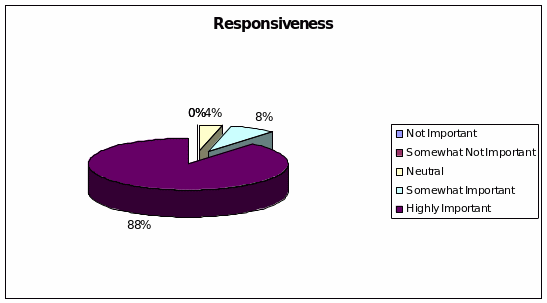
The graph illustrated above depicts the results of the questionnaire survey specific to the responsiveness section. The results state that 0 percent people did not expected responsiveness in the service quality of Singapore Airlines to be important. 0 percent people expected responsiveness in the service quality of Singapore Airlines to be somewhat not important. 4 percent people were neutral in their expectations for responsiveness in the service quality of Singapore Airlines. 8 percent people expected responsiveness in the service quality of Singapore Airlines to be somewhat important. 88 percent people expected responsiveness in the service quality of Singapore Airlines to be highly important
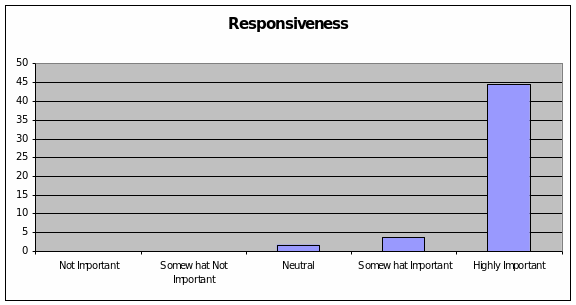
The graph illustrated above shows a bar chart depicting the number of respondents that responded to the questionnaire. It states that 0 responses indicated that people did not expected responsiveness in the service quality of Singapore Airlines to be important. 0 responses indicated that people expected responsiveness in the service quality of Singapore Airlines to be somewhat not important. 1.75 responses indicated that people were neutral in their expectations for responsiveness in the service quality of Singapore Airlines. 3.75 responses indicated that people expected responsiveness in the service quality of Singapore Airlines to be somewhat important. 44.5 responses indicated that people expected responsiveness in the service quality of Singapore Airlines to be highly important
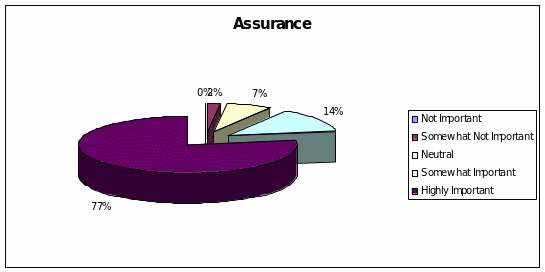
The graph illustrated above depicts the results of the questionnaire survey specific to the assurance section. The results state that 0 percent people did not expect assurance in the service quality of Singapore Airlines to be important. 2 percent people expected assurance in the service quality of Singapore Airlines to be somewhat not important. 6.5 percent people were neutral in their expectations for assurance in the service quality of Singapore Airlines. 14 percent people expected assurance in the service quality of Singapore Airlines to be somewhat important.77.5 percent people expected assurance in the service quality of Singapore Airlines to be highly important.
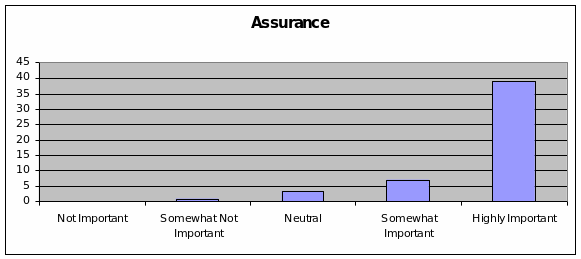
The graph illustrated above shows a bar chart depicting the number of respondents that responded to the questionnaire. It states that 0 responses indicated that people did not expect assurance in the service quality of Singapore Airlines to be important. 1 response indicated that people expected assurance in the service quality of Singapore Airlines to be somewhat not important. 3.25 responses indicated that people were neutral in their expectations for assurance in the service quality of Singapore Airlines. 7 responses indicated that people expected assurance in the service quality of Singapore Airlines to be somewhat important. 38.75 responses indicated that people expected assurance in the service quality of Singapore Airlines to be highly important
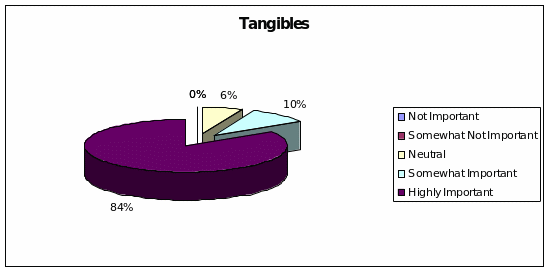
The graph illustrated above depicts the results of the questionnaire survey specific to the tangibles section. The results state that 0 percent people did not expect tangibles in the service quality of Singapore Airlines to be important. 0 percent people expected tangibles in the service quality of Singapore Airlines to be somewhat not important. 6.4 percent people were neutral in their expectations for tangibles in the service quality of Singapore Airlines. 9.6 percent people expected tangibles in the service quality of Singapore Airlines to be somewhat important. 84 percent people expected tangibles in the service quality of Singapore Airlines to be highly important.
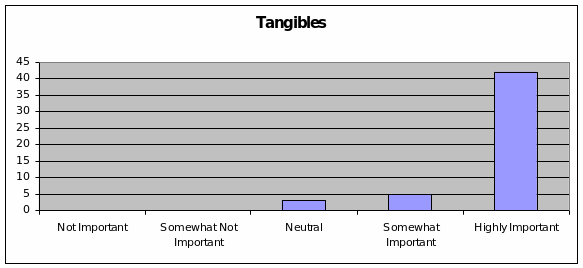
The graph illustrated above shows a bar chart depicting the number of respondents that responded to the questionnaire. It states that 0 responses indicated that people did not expect tangibles in the service quality of Singapore Airlines to be important. 0 responses indicated that people expected tangibles in the service quality of Singapore Airlines to be somewhat not important. 3.2 responses indicated that people were neutral in their expectations for tangibles in the service quality of Singapore Airlines. 4.8 responses indicated that people expected tangibles in the service quality of Singapore Airlines to be somewhat important. 42 responses indicated that people expected tangibles in the service quality of Singapore Airlines to be highly important
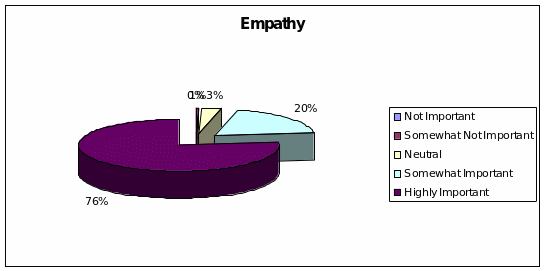
The graph illustrated above depicts the results of the questionnaire survey specific to the empathy section. The results state that 0 percent people did not expect empathy in the service quality of Singapore Airlines to be important. 0.5 percent people expected empathy in the service quality of Singapore Airlines to be somewhat not important.
3 percent people were neutral in their expectations for empathy in the service quality of Singapore Airlines. 19.75 percent people expected empathy in the service quality of Singapore Airlines to be somewhat important. 77 percent people expected empathy in the service quality of Singapore Airlines to be highly important.
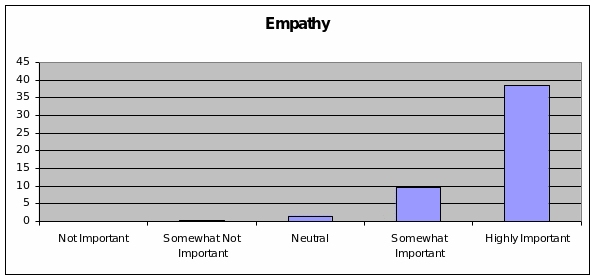
The graph illustrated above shows a bar chart depicting the number of respondents that responded to the questionnaire. It states that 0 responses indicated that people did not expect empathy in the service quality of Singapore Airlines to be important. 0.25 responses indicated that people expected empathy in the service quality of Singapore Airlines to be somewhat not important. 1.5 responses indicated that people were neutral in their expectations for empathy in the service quality of Singapore Airlines. 9.75 responses indicated that people expected empathy in the service quality of Singapore Airlines to be somewhat important. 38.5 responses indicated that people expected empathy in the service quality of Singapore Airlines to be highly important
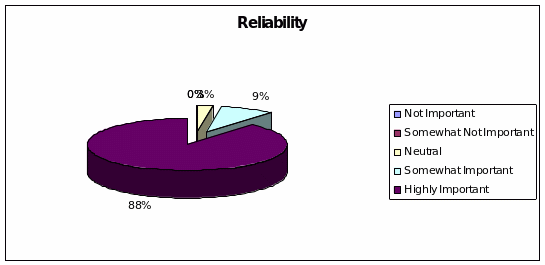
The graph illustrated above depicts the results of the questionnaire survey specific to the reliability section. The results state that 0 percent people did not expect reliability in the service quality of Singapore Airlines to be important. 0 percent people expected reliability in the service quality of Singapore Airlines to be somewhat not important.
2.5 percent people were neutral in their expectations for reliability in the service quality of Singapore Airlines. 9 percent people expected reliability in the service quality of Singapore Airlines to be somewhat important. 88.5 percent people expected reliability in the service quality of Singapore Airlines to be highly important.
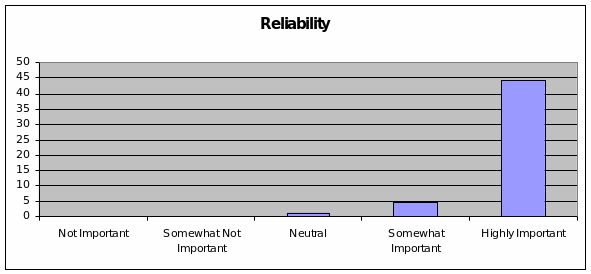
The graph illustrated above shows a bar chart depicting the number of respondents that responded to the questionnaire. It states that 0 responses indicated that people did not expected reliability in the service quality of Singapore Airlines to be important. 0 responses indicated that people expected reliability in the service quality of Singapore Airlines to be somewhat not important. 1.25 responses indicated that people were neutral in their expectations for reliability in the service quality of Singapore Airlines. 4.5 responses indicated that people expected reliability in the service quality of Singapore Airlines to be somewhat important. 44.75 responses indicated that people expected reliability in the service quality of Singapore Airlines to be highly important
The following graphs depict the survey results in terms of the satisfaction level of the customers form the services offered by the Singapore Airlines.
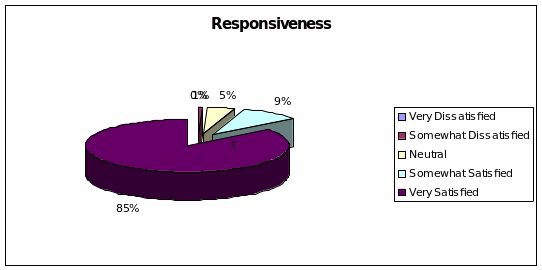
The graph illustrated above depicts the results of the questionnaire survey specific to the responsiveness section. The results state that 0 percent people were very dissatisfied with the responsiveness aspect of the service quality of Singapore Airlines. 0.5 percent people were somewhat dissatisfied with the responsiveness aspect of the service quality of Singapore Airlines. 4.5 percent people were neutral in their customer satisfaction for the responsiveness aspect of the service quality of Singapore Airlines.
9.5 percent people were somewhat satisfied with the responsiveness aspect of the service quality of Singapore Airlines. 85.5 percent people were very satisfied with the responsiveness aspect of the service quality of Singapore Airlines.

The graph illustrated above shows a bar chart depicting the number of respondents that responded to the questionnaire. It states that 0 responses indicated that people were very dissatisfied with the responsiveness of the service quality of Singapore Airlines. 0.25 responses indicated that people were somewhat dissatisfied with the responsiveness of the service quality of Singapore Airlines. 2.25 responses indicated that people were neutral in their satisfaction level with the responsiveness of the service quality of Singapore Airlines. 4.75 responses indicated that people were very somewhat satisfied with the responsiveness of the service quality of Singapore Airlines.42.75 responses indicated that people were very satisfied with the responsiveness of the service quality of Singapore Airlines.
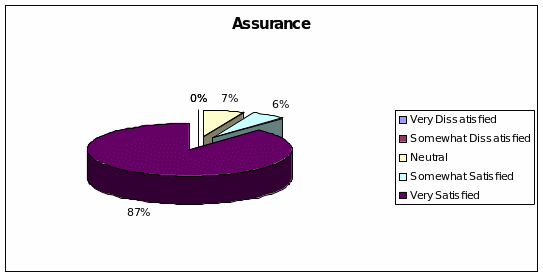
The graph illustrated above depicts the results of the questionnaire survey specific to the assurance section. The results state that 0 percent people were very dissatisfied with the assurance aspect of the service quality of Singapore Airlines. 0 percent people were somewhat dissatisfied with the assurance aspect of the service quality of Singapore Airlines. 6.5 percent people were neutral in their customer satisfaction for the assurance aspect of the service quality of Singapore Airlines. 5.5 percent people were somewhat satisfied with the assurance aspect of the service quality of Singapore Airlines.
88 percent people were very satisfied with the assurance aspect of the service quality of Singapore Airlines.
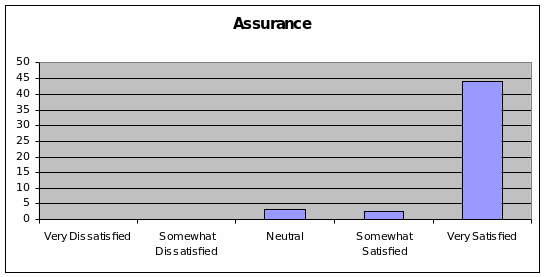
The graph illustrated above shows a bar chart depicting the number of respondents that responded to the questionnaire. It states that 0 responses indicated that people were very dissatisfied with the assurance of the service quality of Singapore Airlines. 0 responses indicated that people were somewhat dissatisfied with the assurance of the service quality of Singapore Airlines. 3.25 responses indicated that people were neutral in their satisfaction level with the assurance of the service quality of Singapore Airlines. 2.75 responses indicated that people were very somewhat satisfied with the assurance of the service quality of Singapore Airlines. 44 responses indicated that people were very satisfied with the assurance of the service quality of Singapore Airlines.
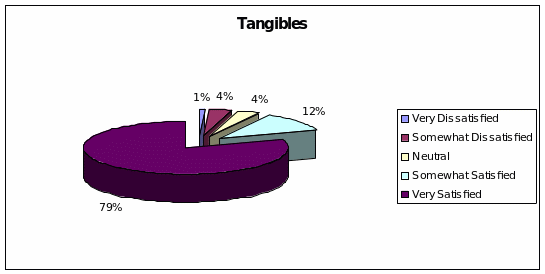
The graph illustrated above depicts the results of the questionnaire survey specific to the tangibles section. The results state that 0.8 percent people were very dissatisfied with the tangibles aspect of the service quality of Singapore Airlines. 3.6 percent people were somewhat dissatisfied with the tangibles aspect of the service quality of Singapore Airlines. 3.6 percent people were neutral in their customer satisfaction for the tangibles aspect of the service quality of Singapore Airlines. 11.6 percent people were somewhat satisfied with the tangibles aspect of the service quality of Singapore Airlines. 80.4 percent people were very satisfied with the tangibles aspect of the service quality of Singapore Airlines.
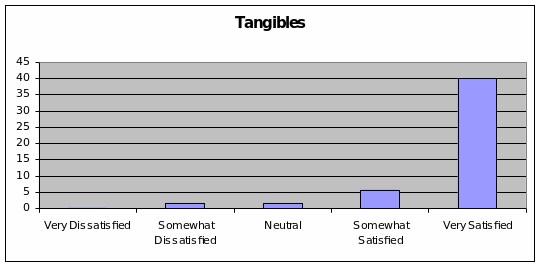
The graph illustrated above shows a bar chart depicting the number of respondents that responded to the questionnaire. It states that 0.4 responses indicated that people were very dissatisfied with the tangibles of the service quality of Singapore Airlines. 1.8 responses indicated that people were somewhat dissatisfied with the tangibles of the service quality of Singapore Airlines. 1.85 responses indicated that people were neutral in their satisfaction level with the tangibles of the service quality of Singapore Airlines. 5.8 responses indicated that people were very somewhat satisfied with the tangibles of the service quality of Singapore Airlines. 40.2 responses indicated that people were very satisfied with the tangibles of the service quality of Singapore Airlines.
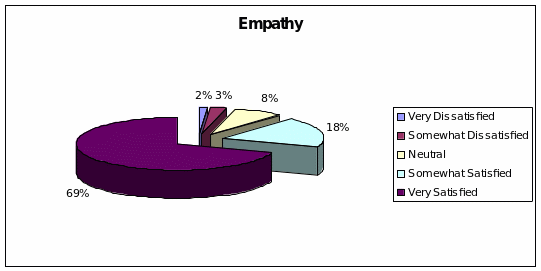
The graph illustrated above depicts the results of the questionnaire survey specific to the empathy section. The results state that 1.5 percent people were very dissatisfied with the empathy aspect of the service quality of Singapore Airlines. 2.5 percent people were somewhat dissatisfied with the empathy aspect of the service quality of Singapore Airlines. 8 percent people were neutral in their customer satisfaction for the empathy aspect of the service quality of Singapore Airlines. 18.5 percent people were somewhat satisfied with the empathy aspect of the service quality of Singapore Airlines. 69.5 percent people were very satisfied with the empathy aspect of the service quality of Singapore Airlines.
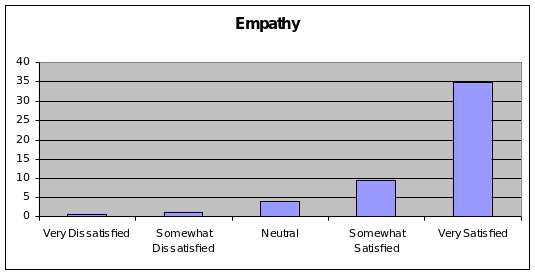
The graph illustrated above shows a bar chart depicting the number of respondents that responded to the questionnaire. It states that 0.75 responses indicated that people were very dissatisfied with the empathy of the service quality of Singapore Airlines.
1.25 responses indicated that people were somewhat dissatisfied with the empathy of the service quality of Singapore Airlines. 4 responses indicated that people were neutral in their satisfaction level with the empathy of the service quality of Singapore Airlines. 9.25 responses indicated that people were very somewhat satisfied with the empathy of the service quality of Singapore Airlines. 34.75 responses indicated that people were very satisfied with the empathy of the service quality of Singapore Airlines.
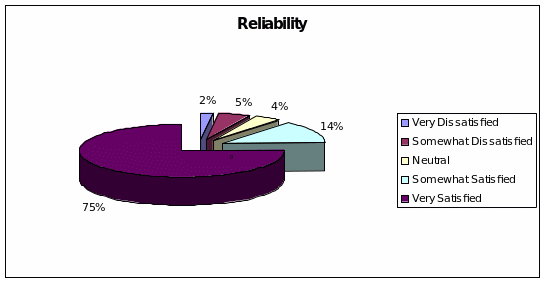
The graph illustrated above depicts the results of the questionnaire survey specific to the reliability section. The results state that 2 percent people were very dissatisfied with the reliability aspect of the service quality of Singapore Airlines. 5 percent people were somewhat dissatisfied with the reliability aspect of the service quality of Singapore Airlines. 4 percent people were neutral in their customer satisfaction for the reliability aspect of the service quality of Singapore Airlines. 13.5 percent people were somewhat satisfied with the reliability aspect of the service quality of Singapore Airlines. 75.5 percent people were very satisfied with the reliability aspect of the service quality of Singapore Airlines.
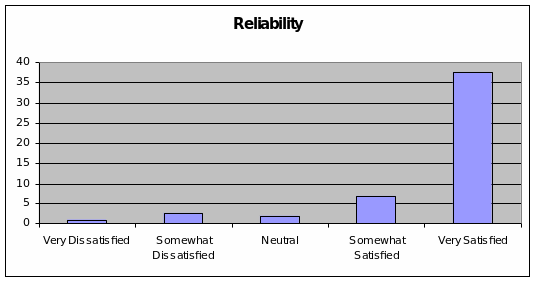
The graph illustrated above shows a bar chart depicting the number of respondents that responded to the questionnaire. It states that 1 response indicated that people were very dissatisfied with the reliability of the service quality of Singapore Airlines. 2.5 responses indicated that people were somewhat dissatisfied with the reliability of the service quality of Singapore Airlines. 2 responses indicated that people were neutral in their satisfaction level with the reliability of the service quality of Singapore Airlines. 6.75 responses indicated that people were very somewhat satisfied with the reliability of the service quality of Singapore Airlines. 37.75 responses indicated that people were very satisfied with the reliability of the service quality of Singapore Airlines.
Analysis
The literature review provided that service based company is largely driven by the quality and the high standard if service it provides to its customers. The service itself is tangible but with and without a direct relation to a physical product, can greatly influence the customer satisfaction level of the consumer. Service industries like the airline industry have certain characteristics which pertain to the facts that “the “service” product, cannot be stored, is difficult to demonstrate, cannot be resold, and closely links the production and consumption processes. Thus, much of the thinking that has been developed to aid the effective running of manufacturing industry is largely redundant when it comes to examining service management. The social linkage between producer and consumer lies at the heart of the process. The “quality” of the service lies in the perceptions of the consumer about how the interaction is managed. These interactions or “moments of truth” as they have been called are at the heart of the success of a service business. The critical factor in service industries is that customers do deal with a particular organization, a bank, insurance company, or garage; because they have gained an impression from the people in that company that they can help. It is this belief that determines the choice of whom they do business with. Once the customer has formed an impression of the helpfulness of an organization, the price or the precise specification of the product becomes of second order importance.” (Bruce, 1987)
The airline industry has been strongly affected by the events of the 9/11, whereby the perception of the customers about flying and important elements of airline service have dynamically changed. A study was conducted to determine the consumer purchase decisions specific to the traveling overseas that’s depicts that “reasons for travel, frequency of travel, class of flight, and type of airline used influenced the level of importance attached by consumers to different elements of the service offering.” (Oyewole &Choudhury, 2006) research also indicates that the service quality and the service levels of a company improve customers’ satisfaction which in turn has an effect on the performance of the company in general. “Increasing customer service raises customer satisfaction and that increasing customer satisfaction improves corporate performance.” (Dresner & Kefeng, 1995)
While trade in the airline industry is growing, the performance if the airlines and the general satisfaction level of the customers has been decreasing exponentially. “One of the biggest problems today within the airline industry is the constant complaining from customers regarding the deterioration of service. Since 1995, unfortunately no airline has been immune from service deterioration” (Hunter, 2006). This is largely due to the increasing competition in the airline industry and the conservative approach of the people towards flying after the September 11 terrorist attacks. The airline companies therefore have sought to differentiate their products and services form others in the industry by providing more customized services to the customers. Literature review depicted that Scandinavian Airlines System was structured as per the demands and the recommendations of the customers, instead of those of the company and its management. “One of the key issues in the paper is the way SAS has chosen to develop the new services, namely to allow the passengers to define the process as op posed to defining it from the company perspective.” (Gustafsson, Ekdahl & Edvardsson, 1999) the literature review also indicated that variations in the services provided to the customers and the high degree of customization has differentiated effects on the satisfaction level of the customers. Results of the study depict that “the relationship between process variation and customer dissatisfaction is contingent upon a company’s average performance with regard to each process. Consistency is at least as important as average performance for high performers, while it has limited impact for low performers.” (Tsikriktsis & Heineke, 2004)
Davidson (1978), discussed in his research the importance of managing customer contacts specifically in the service industries. The reason that was provided for managing the contacts was to increase customer loyalty, promote repeat purchase of the services as well as to create a position for the company in the market specific to the perceptions of the customers about the company and is service quality standards. Another research by Oyewole in 2002 also highlighted that moods and quality of life can also greatly influence the satisfaction level of the customer. The moods of the customer as well as the quality of life “tend to have significant influence on the level of satisfaction with services in the airline industry. However, some elementary services tend to be more influenced than others by these affective states of the consumer.” (Oyewole, 2002) As a result the airlines, specifically Singapore Airlines tries to improve the mood of the customers with specially designed in fight facilities and services.
The results of the primary research conducted via the questionnaire instrument depicted that the customers expect the responsiveness of the services provided by the Singapore Airlines to be most important. The second most important aspect of the customer service expected from Singapore Airlines is the reliability of the staff and the services followed by the physical and tangibles facility based services provided by Singapore Airlines to its customers. After the physical aspect of the service rendered by Singapore Airlines to its customers, the assurance aspect of the services provided by Singapore Airlines was considered important by the respondents. The least important aspect of the service quality which was expected by the respondents pertained to empathy from the staff.
The results of the primary research conducted via the questionnaire instrument depicted that the customer satisfaction level from the assurance of services provided by the Singapore Airlines to be very high. The next best service level of the Singapore Airlines in terms of customer satisfaction was responsiveness of the staff. This was followed by the physical and tangibles facility based services provided by Singapore Airlines to its customers. After the physical aspect of the service rendered by Singapore Airlines to its customers, the reliability of the products and services provided by Singapore Airlines was rated as providing them with high level of customer satisfaction. The aspect of the service quality which generated the least amount of customer satisfaction for the customers was the empathy they received from the Singapore Airlines staff.
Conclusions
The Singapore Airlines is a company which started off as a small entity providing focused and niche products and services to customers, however due to the changes taking place in the airline industry, the increasing traffic of the customers to and form destinations in the Asia Pacific and the increase in the economic structure of Singapore, the company has been able to create itself as a global brand. The company is regarded as one of the most appreciated and liked brands for airlines by customers. Moreover the company has received accolades and rewards for its level of excellence pertaining to the products and services provided to the customers. Similarly the company has also received recommendations form customers as being the airline which is highly focused on maximizing customer satisfaction.
The literature review provided that the Singapore Airlines has been striving for high level of customer satisfaction by innovating the facilities it provides to its customers on the land as well as in flight. The company has launched internet and email base communication services, in flight gamming, lay in flat bed seats as well as luxury delicacies on the menu for onboard. Aside from this the company has also arranges its lounges in such a manner to make their aesthetically pleasing and create a mood for the customers.
The questionnaire based research conducted on the service quality and customer satisfaction provided that the respondents who had made use of Singapore Airlines services at least once in the past 12 to 18 months depicted that in terms of expectation from service quality standards responsiveness of the Singapore Airlines staff was most importance followed by the reliability of the services and the staff, the tangible physical aspect of the services, the assurance provided by the staff. Similarly the customer satisfaction was maximized for the customers through assurance, followed by responsiveness, the tangible aspect of the service, and reliability of the services. However for expectations as well as customer satisfaction level empathy was considered to be least important and satisfying.
The limitation of the research undertaken on the service quality level of the Singapore Airlines and the customer satisfaction level of customers for the Singapore Airlines pertain to the fact that the study was specifically conducted on Singapore Airlines customers. The subject mater dealt with the service quality deliverance and standards of the Singapore Airlines and therefore makes results of the dissertation restriction in their applicability to the general airline or service industry. On a very high level the comprehensive results of the study from the literature review can be used by other airline companies to determine the innovations and the changes that they need to make in order to improve their service quality standards and increase the satisfaction level of their customers. The primary research however is very specific to Singapore Airlines and cannot be generalized to other companies. Aside from this the respondents for the data gathering through questionnaire were contacted through two significantly different channels which could have resulted in a difference in the overall results of the questionnaire based survey research.
The future research that can be conducted on the topic pertains to determining the effect that consumer perception of the brand name have on the service level and quality of the airline companies and how this in turn can effect the customer satisfaction level. Other aspects of the study that can be further developed upon are the linkages of the mood and the standard of living of the customer which can have an effect on the customer satisfaction level from the services offered by an airline.
References
Natalisa, D., Subroto, B., (2003), ‘Effects of Management Commitment on Service Quality to Increase Customer Satisfaction of Domestic Airlines in Indonesia’, Singapore Management Review, Vol. 25 Issue 1, p85, 20p, 3 diagrams, Web.
2007, ‘Company Profile: Singapore Airlines Limited’, Datamonitor Reports, Web.
2006, ‘Winning Wingers’, Logistics Management, Vol. 45 Issue 8, p43-43, 1p, Web.
Wirtz, J., Heracleous, L., Pangarkar, L., 2008, ‘Managing human resources for service excellence and cost effectiveness at Singapore Airlines’, Managing Service Quality, Vol. 18 Issue 1, p4-19, 16p, Web.
Singh, K., 1984, ‘Successful Strategies — The Story of Singapore Airlines (SIA)’, Long Range Planning, Vol. 17 Issue 5, p17-22, 6p, Web.
Ramaswamy, K., 2002, Singapore International Airlines: Strategy with a Smile, Thunderbird International Business Review, Vol. 44 Issue 4, p533-555, 23p, 8 charts, 2 maps, Web.
Frost, F.A., Kumar, M., 2000, ‘INTSERVQUAL – an internal adaptation of the GAP model in a large service organization’, Journal of Services Marketing, Vol. 14 Issue 4/5, p358, 19p, 6 diagrams, Web.
2004, ‘WSJ.com to Offer Audience Search Service’, Information Today, Vol. 21 Issue 5, p44-44, 0p, 1 color, Web.
Gill, R., 2005, ‘Fly around the world unruffled’, Travel Trade Gazette UK & Ireland, Issue 2687, p62-62, 0p, 1 color, Web.
McKenna, J.T., 1990, ‘Frequent fliers rate top carriers but lament decline of quality service’, Aviation Week & Space Technology, Vol. 133 Issue 13, p64, 1p, 1 graph, Web.
Francis, L., 2002, ‘Silk Air kicks off site for promos and e-ticketing’, Media: Asia’s Media & Marketing Newspaper, p11, 0p, Web.
1994, ‘Under their wings’, Economist, Vol. 331 Issue 7864, p75-75, 0p, Web.
Hargrave-Silk, A., 2005, ‘Power giant moves into branded entertainment space’, Media: Asia’s Media & Marketing Newspaper, p12-12, 0p, 1 color, Web.
Tetzeli, R., 1991, ‘AIRLINE EXECUTIVES RATE THE AIRLINES’, Fortune, Vol. 124 Issue 4, p13-13, 0p, Web.
Durvasula, S., Lysonski, S., Mehta, Subhash C., Buck Peng, T., 2004, ‘Forging relationships with services: The antecedents that have an impact on behavioral outcomes in the life insurance industry’, Journal of Financial Services Marketing, Vol. 8 Issue 4, p314-326, 13p, 2 charts, 1 diagram, Web.
2000, ‘Singapore Airlines’, Incentive, Vol. 174 Issue 9, p192, 1p, Web.
Everson, D., Meckler, L., 2006, ‘How Fliers Can Snare Swankier Service’, Wall Street Journal – Eastern Edition, Vol. 248 Issue 132, pD1-D4, 2p, 1 chart, 1 color, Web.
Quinlan, M.R., Zemke, R., Snider, J., Nemeroff, D., Reinemund, Steven, S., Ayling, R., Singh, K., Perkins, James A., Antonini, Joseph E., Loeb, Walter F., 1991, ‘How Does Service Drive the Service Company’, Harvard Business Review, Vol. 69 Issue 6, p146-146, 9p, 1 illustration, Web.
2004, ‘PASSENGER SERVICE: Singapore Airlines’, Air Transport World, Vol. 41 Issue 2, p28-28, 1p, Web.
Seng, C.C., 2004, ‘Drive for excellence played vital part in building SIA’s brand’, Media: Asia’s Media & Marketing Newspaper, p13-13, 0p, 1 color, Web.
Saywell, I., 2003, ‘SIA Weathers The Storm’, Far Eastern Economic Review, Vol. 166 Issue 51, p76-77, 2p, Web.
2007, ‘High quality dishes’, Travel Weekly Australia, Issue 61, p7-7, 0p, Web.
2000, ‘Executive summary and implications for managers and executives’, Journal of Services Marketing, Vol. 14 Issue 4/5, p377, 1p, Web.
Jou, Rong-Chang, Lam, Soi-Hoi, Hensher, David A, Chen, Chih-Cheng, Kuo, Chung-Wei, 2008, ‘The effect of service quality and price on international airline competition’, Transportation Research: Part E, Vol. 44 Issue 4, p580-592, 13p, Web.
2004, ‘Don’t Make Promises You Can’t Keep’, Asiamoney, Vol. 15 Issue 5, p44-46, 3p, 6 charts, Web.
Heracleous, L., Wirtz, J., 2006, ‘Biometrics: the next frontier in service excellence, productivity and security in the service sector’, Managing Service Quality, Vol. 16 Issue 1, p12-22, 11p, Web.
Heracleous, L., Wirtz, J., Johnston, R., 2004, ‘Cost-Effective Service Excellence: Lessons from Singapore Airlines’, Business Strategy Review, Vol. 15 Issue 1, p33-38, 6p, 1 chart, 2 diagrams, 1 bw, Web.
Carroll, M., 2000, ‘Flying on the Internet’, Far Eastern Economic Review, Vol. 163 Issue 37, p50, 3p, 1 chart, 2 color, Web.
Hyland, C., 2000, ‘WHY NOT LIVE IT UP’, Asian Business, Vol. 36 Issue 4, p52, 2p, 1 chart, 2 color, Web.
Clark, A., ‘Globetrotter’, Director, Vol. 59 Issue 10, p41-41, 0p, Web.
Bociurkiw, M., 1998, ‘Time for champagne’, Forbes, Vol. 162 Issue 13, p68-69, 2p, 2 color, Web.
2003, ‘Rockwell Collins helps put Singapore airlines on the map’, Flight Daily News, Issue 3, p60-60, 0p, Web.
2000, ‘TAKING THE WORK OUT OF BUSINESS TRAVEL’, Asiamoney, Vol. 11 Issue 2, p39-47, 6p, 9 charts, 4 color, Web.
Lott, S., 2006, Asian Tigers, ‘Aviation Week & Space Technology’, Vol. 165 Issue 2, p62-67, 6p, 3 charts, 2 graphs, Web.
Deshpande, R., Hogan, H., 2003, ‘Singapore Airlines: Customer Service Innovation (A)’, Harvard Business School Cases, p1, 27p, Web.
1996, ‘Gracious living, Singapore style’, Economist, Vol. 339 Issue 7962, p30, 0p, 1 cartoon, Web.
2004, ‘BOEING — Singapore Is First Customer for Health Management System’, Aviation Week & Space Technology, Vol. 160 Issue 16, pS2-S2, 0p, Web.
Bold, B., 2004, ‘Oneworld goes after Star Alliance flyers’, Marketing, p12-12, 0p, 1 color, Web.
Velocci Jr., A.L., Bond, D., 2001, ‘SIA Presses for Higher Yields With New Aircraft, IFE Systems’, Aviation Week & Space Technology, Vol. 154 Issue 23, p69, 2p, 1 graph Web.
1998, ‘Singapore gets in-flight gaming’, Air Transport World, Vol. 35 Issue 8, p43, 0p, Web.
2006, ‘Airlines’, Travel Trade Gazette UK & Ireland, p8-9, 2p, 4 color, Web.
2004, ‘Remote check-in opens up’, Travel Trade Gazette UK & Ireland, Issue 2627, p28-28, 0p, Web.
Sandilands, B., 1997, ‘A340/A330s used by the main Asian airlines; The inconvenience of middle seats’, BRW, Vol. 19 Issue 18, p90, 0p, Web.
Oyewole, P.P., Choudhury, P., 2006, ‘Purchase Situations and the Level of Importance that Consumers Attach to Services in the Airline Industry’, Services Marketing Quarterly, Vol. 28 Issue 1, p19-34, 16p, 8 charts, Web.
Dresner, M., Kefeng X., 1995, ‘CUSTOMER SERVICE, CUSTOMER SATISFACTION, AND CORPORATE PERFORMANCE IN THE SERVICE SECTOR’, Journal of Business Logistics, Vol. 16 Issue 1, p23-40, 18p, 5 charts, 1 diagram, Web.
Hunter, Joyce A., 2006, ‘A CORRELATIONAL STUDY OF HOW AIRLINE CUSTOMER SERVICE AND CONSUMER PERCEPTION OF AIRLINE CUSTOMER SERVICE AFFECT THE AIR RAGE PHENOMENON’, Journal of Air Transportation, Vol. 11 Issue 3, p78-109, 32p, Web.
Prokesch, S.E., 1995, ‘Competing on Customer Service: An Interview with British Airways’ Sir Colin Marshall’, Harvard Business Review, Vol. 73 Issue 6, p100-112, 13p, 4 color, Web.
Gustafsson, A., Ekdahl, F., Edvardsson, B., 1999, ‘Customer focused service development in practice – A case study at Scandinavian Airlines System (SAS)’, International Journal of Service Industry Management, Vol. 10 Issue 4, p344, 15p, 7 diagrams, Web.
Dawna L. R., Blaise Waguespack Jr., 2008, ‘Twenty years of service quality performance in the US airline industry’, Managing Service Quality, Vol. 18 Issue 1, p20-33, 14p, Web.
Myong Jae Leel., Geddie, Morgan W., 2006, ‘Impact of an Airline Merger on Customer Satisfaction: The Case of American Airlines/ Trans World Airlines (TWA) Merger’, International Journal of Hospitality & Tourism Administration, Vol. 7 Issue 1, p47-61, 15p, 5, Web.
Moonkyu, L., Cunningham, Lawrence F., 1996, ‘Customer Loyalty in the Airline Industry’, Transportation Quarterly, Vol. 50 Issue 2, p57-72, 16p, 1 chart, 1 diagram, Web.
Tsikriktsis, N., Heineke, J., 2004, ‘The Impact of Process Variation on Customer Dissatisfaction: Evidence from the U.S. Domestic Airline Industry’, Decision Sciences, Vol. 35 Issue 1, p129-141, 13p, Web.
Dennett, C., Ineson, Elizabeth M., Stone, Graham J., Colgate, M., 2000, ‘Pre-bookable Services in the Chartered Airline Industry: Increasing Satisfaction through Differentiation’, Service Industries Journal, Vol. 20 Issue 2, p82-94, 13p, 1 chart, 1 diagram, Web.
Oyewole, 2002, ‘Affective States of the Consumer and Satisfaction with Services in the Airline Industry’, Services Marketing Quarterly; 2002, Vol. 23 Issue 4, p45, 19p, 7 charts, Web.
Michels, J., 2001, ‘Congress Asks: Is There Hope For Better Airline Customer Service’, Travel Agent, Vol. 304 Issue 8, p109, 1p, 1 color, Web.
Bruce, M., 1987, ‘Managing People First–Bringing the Service Concept to British Airways’, Industrial & Commercial Training, Vol. 19 Issue 2, p21, 6p, 1 chart, Web.
2007, ‘Airlines are tempting fate with awful customer service’, Advertising Age, Vol. 78 Issue 27, p12-12, 0p, Web.
Mele, J., 2000, ‘A failure to satisfy’, Fleet Owner, Vol. 95 Issue 8, p2, 0p, Web.
Davidson, David S., 1978, ‘How to succeed in a service industry… Turn the organization chart upside down’, Management Review, Vol. 67 Issue 4, p13, 4p, Web.
D’Agostino, D., 2006, ‘Staying Airborne’, CIO Insight, Issue 70, p43-49, 6p, Web.
Ostrowski, P.L., O’Brien, T.V., 1993, ‘Service quality and customer loyalty in the commercial airline industry’, Journal of Travel Research, Vol. 32 Issue 2, p16, 9p, 6 charts, Web.
Summers, G|.F., Hammonds, A.D., 1969, ‘Toward a Paradigm for Respondent Bias in Survey Research’, Sociological Quarterly, Vol. 10 Issue 1, p113-121, 9p, 1 diagram, Web.
Bullock, R. J., Svyantek, Daniel J., 1983, ‘Positive-Finding Bias in Positive-Findings Bias Research’, Academy of Management Proceedings, p221-224, 4p, 1 chart, Web.
Swan, J.E., O’Connor, Stephen J., Seung Dong Lee, 1991, ‘A Framework for Testing Sampling Bias and Methods of Bias Reduction in a Telephone Survey’, Marketing Research, Vol. 3 Issue 4, p23-34, 12p, 4 charts, 1 diagram, 1 graph, 3 bw, Web.
Krishnan, M.S., Ramaswamy, V., 1999, ‘Customer Satisfaction for Financial Services: The Role of Products, Services, and Information Technology’, Management Science, Vol. 45 Issue 9, p1194-1209, 16p, 3 graphs, Web.
Hallowell, R., Schlesinger, L.A., Zornitsky, J., 1996, ‘Internal Service Quality, Customer and Job Satisfaction: Linkages and Implications for Management’, Human Resource Planning, Vol. 19 Issue 2, p20-31, 12p, 1 chart, 1 diagram, 1 graph, 6 bw, Web.
Jiang, P., Rosenbloom, B., 2005, ‘Customer intention to return online: price perception attribution-level performance, and satisfaction unfolding over time’, European Journal of Marketing, Vol. 39 Issue 1/2, p150-174, 25p, Web.
Griffith, J., 2001, ‘Do Satisfied Employees Satisfy Customers? Support-Services Staff Morale and Satisfaction Among Public School Administrators, Students, and Parents’, Journal of Applied Social Psychology, Vol. 31 Issue 8, p1627-1658, 32p, 5 charts, 1 diagram, 2 graphs, Web.
Yagil, D., 2006, ‘The relationship of service provider power motivation, empowerment and burnout to customer satisfaction’, International Journal of Service Industry Management, Vol. 17 Issue 3/4, p258-270, 13p, 3 charts, 2 diagrams, Web.
Bloemer, José M. M., Lemmink, Jos G. A. M., 1992, ‘The Importance of Customer Satisfaction in Explaining Brand and Dealer Loyalty’, Journal of Marketing Management, Vol. 8 Issue 4, p351-363, 13p, 10 charts, 2 diagrams, Web.
Pothas, A., De Wet, A.G., Marthinus D.W., 2001, ‘Customer satisfaction: Keeping tabs on the issues that matter’, Total Quality Management, Vol. 12 Issue 1, p83-94, 12p, 4 diagrams, Web.
Ming, C.L., Ing, S.H., 2005, ‘Relationships among Service Quality, Customer Satisfaction and Profitability in the Taiwanese Banking Industry’, International Journal of Management, Vol. 22 Issue 4, p635-648, 14p, Web.
Wun-Hwa Chen, Jung-Tang Hsueh, 2006, ‘Application of customer satisfaction study to derive customer knowledge’, Total Quality Management & Business Excellence, Vol. 17 Issue 4, p439-454, 16p, 4 charts, 2 diagrams, 1 graph, Web.
Saura, I.G., Contrí, G.B., Taulet, A.C., Velázquez, B.M., 2005, ‘Relationships among customer orientation, service orientation and job satisfaction in financial services’, International Journal of Service Industry Management, Vol. 16 Issue 5, p497-525, 29p, Web.
Ngobo, P.V., 2004, ‘Drivers of customers’ cross-buying intentions’, European Journal of Marketing, Vol. 38 Issue 9/10, p1129-1157, 29p, Web.
Sui-Hua Yu, 2007, ‘An Empirical Investigation on the Economic Consequences of Customer Satisfaction’, Total Quality Management & Business Excellence, Vol. 18 Issue 5, p555-569, 15p, 6 charts, 1 diagram, Web.
Bryant, B.E., 1995, ‘Customer Satisfaction by Industry Among Demographic and Socioeconomic Groups’, Working Papers (Faculty) — University of Michigan Business School, p1, 32p, Web.
Moses, John D., 1995, ‘The Customer Satisfaction Factor: The Value of Conducting Employee Evaluations of Managed Care Networks’, Benefits Quarterly, Vol. 11 Issue 2, p43-47, 5p, Web.
Stock, R.M., 2005, ‘Can Customer Satisfaction Decrease Price Sensitivity in Business-to-Business Markets’, Journal of Business-to-Business Marketing, Vol. 12 Issue 3, p59-87, 29p, Web.
Shankar, V., Smith, Amy K., Rangaswamy, A., 2003, ‘Customer satisfaction and loyalty in online and offline environments’, International Journal of Research in Marketing, Vol. 20 Issue 2, p153, 23p, Web.
Iacobucci, D., Ostrom, A., Grayson, K., 1995, ‘Distinguishing Service Quality and Customer Satisfaction: The Voice of the Consumer’, Journal of Consumer Psychology, Vol. 4 Issue 3, p277, 27p, 1 chart, 3 diagrams, 4 graphs, Web.